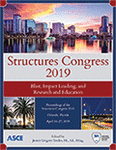Structures Congress 2019
Full Scale 13-Story Building Implosion and Collapse: Effects on Adjacent Structures
Publication: Structures Congress 2019: Blast, Impact Loading, and Research and Education
ABSTRACT
A pair of decommissioned thirteen-story reinforced concrete buildings were demolished via controlled implosion at the University of Nebraska–Lincoln in December 2017. The implosion consisted of controlled charges at select columns on alternating floors throughout the buildings, which initiated the collapse of the two buildings. This controlled implosion provided the rare opportunity to monitor and characterize the collapse progression of the buildings as well as the response of nearby and adjacent structures to both the remote blast loading and the subsequent building collapse. To this end, sacrificial accelerometers were placed throughout the two buildings before the collapse to record the buildings’ motions and load redistribution. In addition to these sensors, additional accelerometers were placed in the free-field and within three nearby structures, including two immediately adjacent structures as well as one high-rise at an approximate distance of 0.25 mile. These sensors monitored the adjacent structures before, during, and after the collapse to understand the impact of the collapse. While no noticeable damage nor shift in the natural frequencies was observed in the adjacent structures, each exhibited observable response to both the blast sequence as well as the collapse sequence of the buildings, with accelerations on the order of 0.08 g at the ground outside the closest building and 0.002 g at the furthest structure. In this paper, this unique experimental dataset obtained from the adjacent structures will be introduced alongside key observations of the performance of these adjacent structures during the blast and collapse of the two buildings.
Get full access to this article
View all available purchase options and get full access to this chapter.
ACKNOWLEDGMENTS
The authors gratefully acknowledge the support of Dr. Daniel G. Linzell at the University of Nebraska-Lincoln and the Voelte-Keegan Professorship for financial support of sensor acquisition and collaboration on the monitoring aspects of this project. In addition, access to adjacent structures was provided by Mr. Larry Shippen of University of Nebraska-Lincoln University Housing and Facilities Maintenance & Operations. Particular thanks are extended to Ms. Yijun Liao and Mr. Garrett Martindale for their assistance in instrumentation of the adjacent structures. Moreover, supplemental instrumentation used in this study was graciously provided in collaboration with Dr. Babak Moaveni of Tufts University.
REFERENCES
Çelebi, M. (1993a). "Seismic Responses of Two Adjacent Buildings. I: Data and Analyses." Journal of Structural Engineering, 119(8), 2461-2476.
Çelebi, M. (1993b). "Seismic Responses of Two Adjacent Buildings. II: Interaction." Journal of Structural Engineering, 119(8), 2477-2492.
Kobori, T., Minai, R., Kusakabe, K. (1977). “Dynamical cross-interaction between two foundations.” Proceedings: 6thWorld Conference on Earthquake Engineering. New Delhi, India.
LS-DYNA. (2018). Livemore Software Technology Corporation (LSTC), Livemore, California.
Mizuno, H. (1980). “Effects of structure–soil–structure interaction during various excitations.” Proceedings: 7thWorld Conference on Earthquake Engineering. Istanbul, Turkey.
Menglin, L., Huaifeng, W., Xi, C., and Yongmei, Z. (2011). "Structure-Soil-Structure Interaction: Literature Review." Soil Dynamics and Earthquake Engineering, 31, 1724-1731.
Trifunac, M. D., and A.G. Brady (1975). “A Study on Duration of Strong Earthquake Ground Motion.” Bulletin of the Seismological Society America, 65, 581–626.
Information & Authors
Information
Published In
Structures Congress 2019: Blast, Impact Loading, and Research and Education
Pages: 82 - 92
Editor: James Gregory Soules, McDermott International
ISBN (Online): 978-0-7844-8224-7
Copyright
© 2019 American Society of Civil Engineers.
History
Published online: Apr 22, 2019
Published in print: Apr 22, 2019
Authors
Metrics & Citations
Metrics
Citations
Download citation
If you have the appropriate software installed, you can download article citation data to the citation manager of your choice. Simply select your manager software from the list below and click Download.
